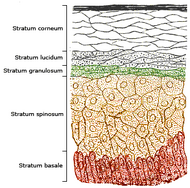(New page: {{BioPsy}} {{Infobox Anatomy | Name = Stratum corneum | Latin = stratum corneum epidermidis | GraySubject = 234 | GrayPage = 1064 | Image = Skinlayers....) |
No edit summary |
||
| Line 18: | Line 18: | ||
The '''stratum corneum''' ("horny layer") is the outermost layer of the [[epidermis (skin)|epidermis]] (the outermost layer of the [[skin]]). It is composed mainly of dead [[cell (biology)|cell]]s that lack [[cell nucleus|nuclei]]. As these dead cells slough off, they are continuously replaced by new cells from the [[stratum germinativum]] (basale). In the human forearm, for example, about 1300 cells/cm<sup>2</sup>/hr are shed and commonly accumulate as house dust. This outer layer that is sloughed off is also known as the stratum dysjunction. |
The '''stratum corneum''' ("horny layer") is the outermost layer of the [[epidermis (skin)|epidermis]] (the outermost layer of the [[skin]]). It is composed mainly of dead [[cell (biology)|cell]]s that lack [[cell nucleus|nuclei]]. As these dead cells slough off, they are continuously replaced by new cells from the [[stratum germinativum]] (basale). In the human forearm, for example, about 1300 cells/cm<sup>2</sup>/hr are shed and commonly accumulate as house dust. This outer layer that is sloughed off is also known as the stratum dysjunction. |
||
| − | Cells of the stratum corneum contain [[keratin]], a [[protein]] that helps keep the skin hydrated by preventing [[water]] |
+ | Cells of the stratum corneum contain [[keratin]], a [[protein]] that helps keep the skin hydrated by preventing [[water]] evaporation. In addition, these cells can also [[absorption|absorb]] water, further aiding in hydration and explaining why humans and other animals experience wrinkling of the skin on the [[finger|fingers]] and [[toes]] (colloquially called "pruning") when immersed in water for prolonged periods. |
The thickness of the stratum corneum varies according to the amount of protection and/or grip required by a region of the body. For example, the [[hand]]s are typically used to grasp objects, requiring the palms to be covered with a thick stratum corneum. Similarly, the [[sole]] of the [[foot]] is prone to injury, and so it is protected with a thick stratum corneum layer. In general, the stratum corneum contains 15 to 20 layers of dead cells. The stratum corneum has a thickness between 10 and 40 μm. (=0.04mm) |
The thickness of the stratum corneum varies according to the amount of protection and/or grip required by a region of the body. For example, the [[hand]]s are typically used to grasp objects, requiring the palms to be covered with a thick stratum corneum. Similarly, the [[sole]] of the [[foot]] is prone to injury, and so it is protected with a thick stratum corneum layer. In general, the stratum corneum contains 15 to 20 layers of dead cells. The stratum corneum has a thickness between 10 and 40 μm. (=0.04mm) |
||
Latest revision as of 12:02, 9 April 2008
Assessment |
Biopsychology |
Comparative |
Cognitive |
Developmental |
Language |
Individual differences |
Personality |
Philosophy |
Social |
Methods |
Statistics |
Clinical |
Educational |
Industrial |
Professional items |
World psychology |
Biological: Behavioural genetics · Evolutionary psychology · Neuroanatomy · Neurochemistry · Neuroendocrinology · Neuroscience · Psychoneuroimmunology · Physiological Psychology · Psychopharmacology (Index, Outline)
| Stratum corneum | ||
|---|---|---|
| Section of epidermis. (Stratum corneum labeled at top left.) | ||
| Latin | stratum corneum epidermidis | |
| Gray's | subject #234 1064 | |
| System | ||
| MeSH | [1] | |
| [[Image:|190px|center|]] | ||
The stratum corneum ("horny layer") is the outermost layer of the epidermis (the outermost layer of the skin). It is composed mainly of dead cells that lack nuclei. As these dead cells slough off, they are continuously replaced by new cells from the stratum germinativum (basale). In the human forearm, for example, about 1300 cells/cm2/hr are shed and commonly accumulate as house dust. This outer layer that is sloughed off is also known as the stratum dysjunction.
Cells of the stratum corneum contain keratin, a protein that helps keep the skin hydrated by preventing water evaporation. In addition, these cells can also absorb water, further aiding in hydration and explaining why humans and other animals experience wrinkling of the skin on the fingers and toes (colloquially called "pruning") when immersed in water for prolonged periods.
The thickness of the stratum corneum varies according to the amount of protection and/or grip required by a region of the body. For example, the hands are typically used to grasp objects, requiring the palms to be covered with a thick stratum corneum. Similarly, the sole of the foot is prone to injury, and so it is protected with a thick stratum corneum layer. In general, the stratum corneum contains 15 to 20 layers of dead cells. The stratum corneum has a thickness between 10 and 40 μm. (=0.04mm)
In reptiles, the stratum corneum is permanent, and is replaced only during times of rapid growth, in a process called ecdysis or moulting. The stratum corneum in reptiles contains beta-keratin, which provides a much more-rigid skin layer.
External links
- MedEd at Loyola medicine/dermatology/skinlsn/stcorn.htm
- Stratum corneum - WebMD anatomy
- Histology at Boston University 08422loa - "Integument: thick skin"
Integumentary system | |
|---|---|
| Structures |
Skin • Sweat glands • Sebaceous glands • Hair (Hair follicle) • Nails • Scale |
| Layers |
Cutis: Epidermis (Stratum corneum, Stratum lucidum, Stratum granulosum, Stratum spinosum, Stratum germinativum/basale) • Dermis |
| This page uses Creative Commons Licensed content from Wikipedia (view authors). |
